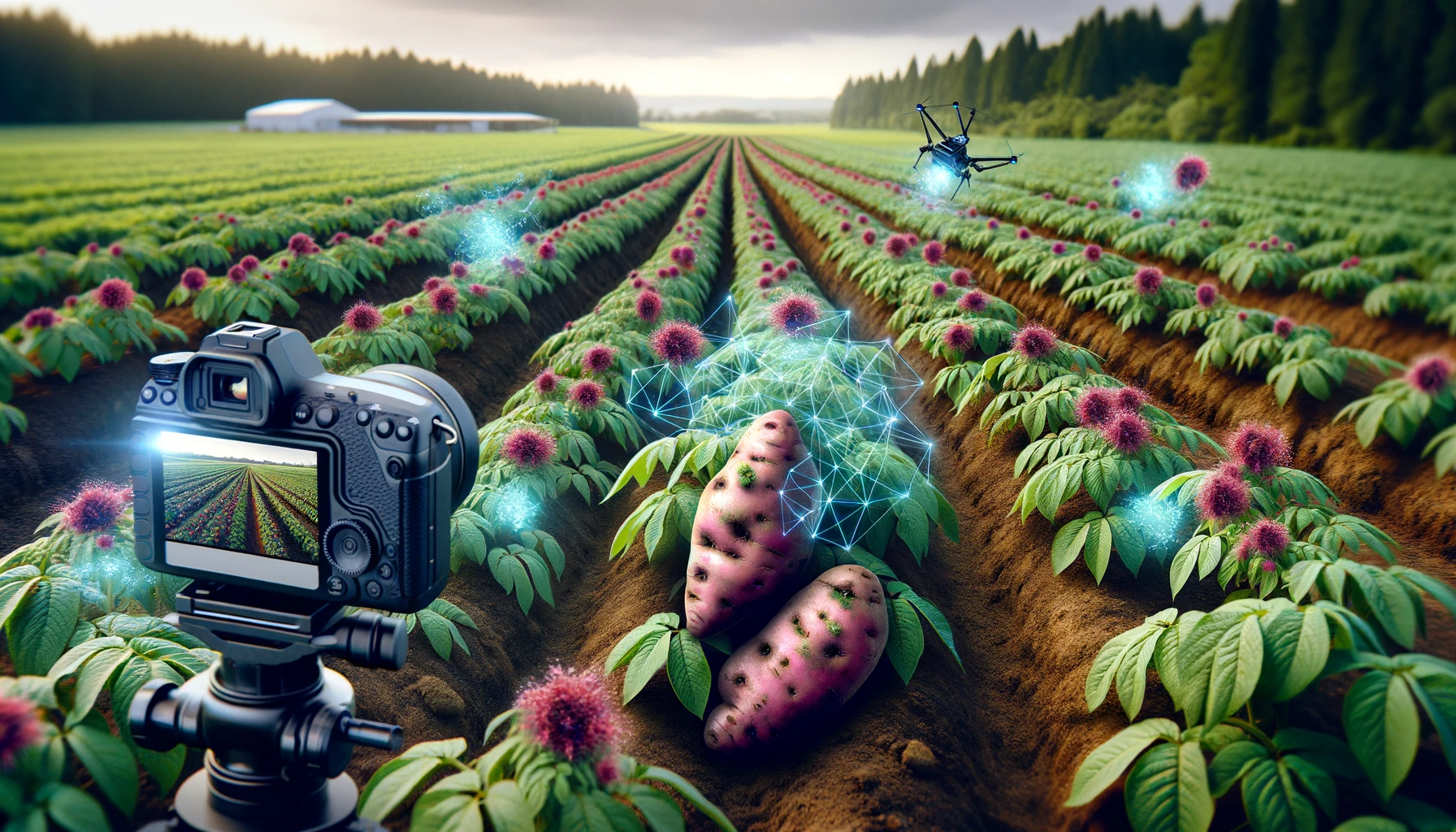In a recent publication in the journal Agronomy, researchers introduced a deep learning-based object detection framework named SPVDet for identifying Sweet Potato Virus Disease (SPVD) in both ground and aerial high-resolution images. A lightweight version, SPVDet-Nano, is proposed, exhibiting superior performance compared to single-level and mainstream feature pyramid detectors.
 Study: Sweet Potato Virus Disease Detection Using Deep Learning-Based Object Detection Framework. Image credit: Generated using DALL.E.3
Study: Sweet Potato Virus Disease Detection Using Deep Learning-Based Object Detection Framework. Image credit: Generated using DALL.E.3
Background
Sweet potato (Ipomoea batatas) holds significant economic importance, ranking as the fifth most crucial tropical food crop globally. It serves various purposes, including food, animal feed, and traditional medicine. However, the crop faces challenges from potyviruses, with the most severe being SPVD, causing up to an 85 percent yield reduction. Current management relies on clean planting material, as genetic resistance is unavailable. Detection methods include costly laboratory-based tests and field scouting, which are time-consuming and subjective.
To address the limitations, a novel object detection framework, SPVDet, is proposed for SPVD identification using ground and aerial images. SPVDet-Nano, a lightweight version, demonstrates superior performance.
Benchmark datasets and methodology
For object detection tasks, several benchmark datasets play pivotal roles in evaluating algorithmic performance. The PASCAL Visual Object Classes (VOC) dataset is a widely embraced benchmark for small-scale object detection tasks. The Microsoft Common Objects in Context (MS COCO) 2017 dataset, a large-scale benchmark for generic object detection, surpasses PASCAL VOC in both category diversity and instance count.
Considering the absence of a publicly available dataset for SPVD assessment, a dedicated RGB (Red, Green, and Blue) image dataset was meticulously curated. Covering perspectives from handheld digital cameras to unmanned aerial vehicles (UAVs), this dataset comprises 333 high-resolution RGB images captured under various field conditions. The SPVD dataset not only aids in the quantitative assessment of SPVD but also holds promise for diverse applications, such as smartphone-based SPVD detection and large-scale field studies through UAV-based remote sensing.
Transfer learning enhances the model's ability to learn generalized feature representations. The proposed SPVDet architecture is then fine-tuned for SPVD detection using the specialized SPVD dataset, showcasing its adaptability to specific tasks. To deal with high-resolution imagery efficiently, the authors introduce a compact version of SPVDet, termed SPVDet-Nano. This lightweight yet powerful real-time object detector retains the essential components of SPVDet while incorporating a compressed backbone using a compound scaling method. Additionally, slicing-aided hyper-inference (SAHI) technology is introduced to enable direct inference on original high-resolution images, striking a balance between model complexity and inference speed.
Results and analysis
The primary objective of this study was to evaluate the feasibility of detecting SPVD from RGB high-resolution images using deep learning frameworks, specifically the proposed object detectors SPVDet and SPVDet-Nano. Ablation studies on SPVDet components revealed that the combination of the enhanced feature aggregation module and dynamic decoupled head (DH) detection head, integrated with the ELANNet backbone, produced the best performance. This configuration demonstrated high model accuracy with minimal computational complexity. Hyperparameter fine-tuning, particularly dilation rates, resulted in the highest mean average precision (mAP) of 81.17 percent.
Benchmarking SPVDet against other detectors on the MS COCO dataset showed superior performance, outperforming counterparts such as CenterNet, with the highest mAP of 43.8 under an arbitrary input size. SPVDet-Nano, a lightweight version, achieved real-time inference speed, sacrificing some accuracy, especially in detecting small objects. Applying SPVDet models to detect SPVD biotic stress in plants in the field using SAHI technology yielded significant results. The combination of SPVDet, SAHI, and FI achieved the highest mAP of 30.8, a substantial improvement over direct inference on the SPVD dataset. SAHI enhanced accuracy in detecting small and large objects, with a slight compromise for medium-sized objects. Notably, SPVDet-Nano, designed for real-time inference, exhibited a trade-off, sacrificing accuracy for speed.
Qualitative results visually demonstrated SAHI's effectiveness in improving detection accuracy, particularly in localizing target objects and identifying SPVD-infected plants. The study emphasized the need for further optimization in distinguishing between healthy and infected plants in aerial scenarios. Additionally, an assessment of SPVDet's detection performance from different view angles revealed the close-up view achieved the highest accuracy of 78.1 percent, demonstrating the feasibility of detecting infected plants using image-based deep learning algorithms.
Despite challenges with cluttered backgrounds and overlapping, the UAV view reported a detection accuracy of 76.6 percent, suggesting a promising approach for high-throughput phenotyping plant diseases in large-scale fields. The overlook view reported the lowest accuracy of 55.3 percent, primarily due to discrimination errors regarding false-negative plants.
Conclusion
In summary, the authors explore the advancements of SPVDet and SPVDet-Nano through meticulous architectural design, enhancing detection accuracy and computational efficiency. They establish the viability of SPVD detection in ground-based and UAV aerial high-resolution RGB images, utilizing SAHI techniques.
This pioneering use of a deep learning framework with customer-grade cameras and UAVs holds promise for high-throughput phenotyping on crop plantations. However, challenges such as limited UAV images and variations in SPVD symptoms call for future research to expand datasets and explore the impacts of multiple infections on sweet potato varieties and environmental conditions.